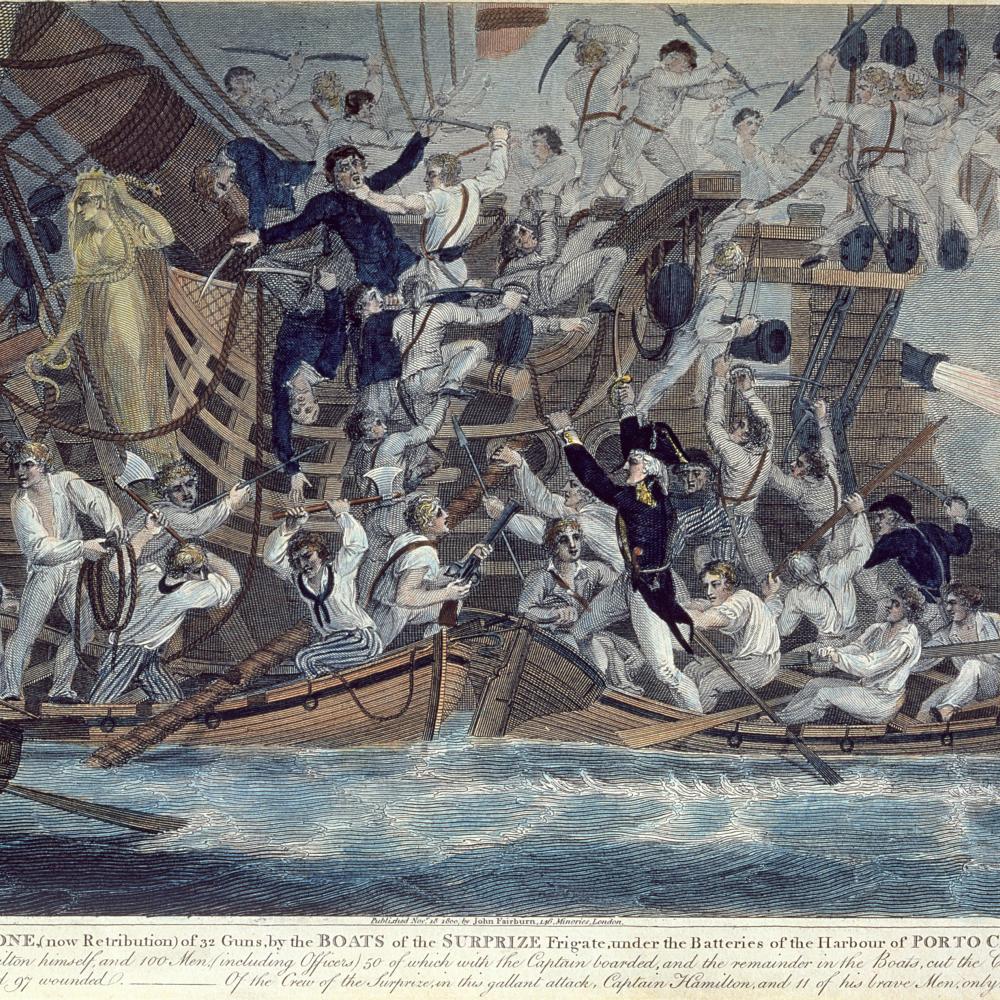A. Roger Ekirch, a professor of history at Virginia Tech, spent eight years exploring the connection between the 1797 bloodbath on HMS Hermione and the hard-fought election in which Thomas Jefferson ousted John Adams as president. In this story, a sailor who claimed he was American was handed over to the British for mutiny and piracy and quickly became a republican hero, with dramatic repercussions for American politics. The “Revolution of 1800,” immigration and citizenship, and the advent of political asylum are covered in a most engaging fashion in American Sanctuary: Mutiny, Martyrdom, and National Identity in the Age of Revolution. Ekirch’s latest book, for which he received NEH funding, is the subject of this edition of IQ.
What was HMS Hermione’s crew doing in the Caribbean in the 1790s?
Hunting prey to plunder. With the outbreak of war between Britain and France in 1793, the Caribbean became hotly contested. The frigate's objective was to seize enemy privateers and merchantmen, including neutral “prizes” belonging to the United States. Her crew earned an especially notorious reputation for impressing American seamen who, the British insisted, were deserters from the Royal Navy, as some no doubt were.
Describe the Hermione’s Captain Hugh Pigot and what inspired the mutiny against him?
Pigot routinely flogged seamen to enforce discipline. He was a breed apart—quick-tempered, erratic, and sadistic. Above all else—from disease and punishing work to radical beliefs spread by the French Revolution—his brutality caused the uprising.
The very morning of the mutiny, Pigot ordered more than a dozen men flogged because they hadn’t descended from the rigging quickly enough as a squall approached. This was after Pigot ordered the corpses of three “topmen” thrown overboard. Those men had plunged to their deaths following Pigot’s threat that he would “flog the last man down!”
How did the mutiny commence?
Savagely. On the night of September 21, a half-dozen armed seamen burst into the captain’s cabin after knocking a sentry senseless, slashed and stabbed Pigot repeatedly, leaving him for dead as they ran to join others who had attacked Lt. Henry Foreshaw on the quarterdeck. When Pigot was discovered still alive, bayonets were buried in his gut, and he was shoved out the starboard cabin window. Before the night’s business was done, nine other officers would be launched overboard. There was little mercy.
Did the British successfully capture the Hermione and its crew?
Following the uprising, the mutineers delivered the frigate to the Spanish in Venezuela. The Royal Navy relentlessly pursued the mutineers, most of whom, more than one hundred, fled to the far shores of the North Atlantic, including to the U.S. In 1799, the British recaptured the frigate, shortly renamed HMS Retribution, at Puerto Cabello.
Which event during the mutiny elicited the strongest feelings in you?
Unlike the mutiny on the Bounty, eight years earlier, which sent her commander and eighteen crewmen adrift in an open launch, events and personalities aboard the Hermione are not easily romanticized. Pigot stands out for his cruelty. Altogether different was poor Foreshaw, who, like other officers, was sacrificed for Pigot’s sins. After Foreshaw was forced overboard, he became entangled in the ship’s rigging. Somehow, he made his way back to the main deck, as if a ghost, his ashen face streaming with blood. “Good God,” he pleaded, “what harm have I ever done to any of you.” The stunned crew members promised mercy that he did not get. “Foreshaw, you bugger,” Thomas Nash shouted. “Are you not overboard yet? Overboard you must go, and overboard you shall go!”
Who was this Thomas Nash fellow?
A native of Waterford, Ireland, who enlisted aboard the Hermione in January 1793—whether by choice or coercion is unclear. A boatswain’s mate with a flowing black mane, he became the mutiny’s chief ringleader owing to his hand in the gruesome deaths of Pigot and Foreshaw.
How did Irishman Thomas Nash morph into American Jonathan Robbins?
Or did he? Both Federalists and the British thought the men one and the same, whereas most Republicans initially championed Robbins’s claim to be a native of Danbury, Connecticut, who had been impressed onto the Hermione. This was a perplexing mystery that I was able to untangle with the aid of logbooks, together with the testimony of former shipmates. Ultimately, the question of his identity became most important for its irrelevance. For a growing number of Americans, more consequential were Robbins’s republican convictions, thereby contributing to a broader conception of U.S. citizenship, based upon volition and belief, not just the vagaries of birth.
Why should Americans care about this historically obscure man?
Arriving aboard an American schooner, Jonathan Robbins was arrested in Charleston, South Carolina, more than a year after the mutiny. With the approval of President John Adams, he was surrendered to the British, who tried, executed, and hung him in chains at the entrance to Port Royal, Jamaica. He became the poster child against British oppression and Federalist failures to combat the impressment of American seamen. His martyrdom as a reputed freedom fighter became the single most decisive issue in the tumultuous election of 1800.
Just how many Americans were pressed into His Majesty’s service?
From 1793 to 1815, roughly 10,000 seamen were seized off U.S. vessels. They included native-born Americans, naturalized citizens, and British deserters who had not been naturalized. Not that naturalization in the U.S. afforded English seamen protection. Citizenship in British eyes was indelible.
Why did President Adams consider it acceptable to turn Jonathan Robbins over to the British?
Another mystery. In March 1799, Adams left Philadelphia to spend much of the spring and summer at his Massachusetts farm. His closest political allies fretted over his isolation. While away, he answered a letter from Secretary of State Timothy Pickering about the Robbins case. In one of the most catastrophic blunders of his administration, Adams agreed “to advise and request” a federal judge in Charleston to give Robbins up, without enquiring whether he had been an American impressed aboard the Hermione. Had Adams first consulted his attorney general, Charles Lee, a moderate Federalist, he likely would have left the seaman’s fate up to a federal court. Perhaps the president was anxious to mollify Britain after the U.S. opted for peace with France. Robbins probably seemed like a minor price to pay to help regain the trust of both Britain and Anglophiles, like Pickering and Alexander Hamilton, in his own party.
Some members of Congress wanted to censure Adams for this action. Why?
Representative Edward Livingston of New York City charged that the president had advised a federal judge to extradite a seaman without a jury trial, despite his claim to be a U.S. citizen, one who had tried to “regain his liberty from illegal imprisonment.” Largely on a party-line vote, the motion to censure Adams failed, but so too did Federalist efforts to pass a resolution approving Adams’s conduct.
Do you think Adams overstepped his bounds in this particular case?
Yes. Adams planted at least one foot over the line by infringing upon the independence of the judiciary.
You describe the election of 1800 as a “battle for the country’s soul.” How so?
The election was the most divisive in American history until Abraham Lincoln’s. Americans in 1800 clashed over the scope of government, the roles of leaders and followers, and the very words and meaning of the Constitution. The race would decide whether the public should continue to accept the guidance of a paternalistic, pro-British ruling class eager to establish the supremacy of the federal government or instead should support political leaders striving to protect liberties won in the Revolution. Partisans on either side feared that the election could erupt in a civil war.
During this time Aaron Burr was constructing the “foundations of America’s first political machine.” What was that machine trying to do?
To elect a Republican president in 1800, either Thomas Jefferson or Burr himself. Never were the stakes higher than in late April when New Yorkers, in the first contest that would determine presidential electors, went to the polls. Burr selected the most impressive slate of state legislative candidates ever to appear on the same ballot, including Horatio Gates, the hero of the Battle of Saratoga, and former Governor George Clinton. Burr established ward committees in New York City, organized rallies, and transformed his home into a campaign headquarters, well stocked with refreshments and mattresses for loyal partisans. But he was evenly matched by Alexander Hamilton, his long-standing nemesis, who directed the Federalist campaign. And yet, despite their efforts, voters ultimately cast ballots on their deepest convictions, hatreds, and fears, with British impressment and the martyred Jonathan Robbins uppermost in many minds.
How did the ghost of Jonathan Robbins change immigration and extradition policies after the election?
Robbins remained a perpetual fixture of Republican campaigns, reaffirming America’s revolutionary mission, voiced by Thomas Paine in 1776, to afford “an asylum for mankind.” Once elected, Jefferson and Congress forcefully underscored this commitment with a liberal naturalization law to encourage immigration. And for 33 years after the seaman’s execution, in order to forestall the “popular clamor” that accompanied his surrender, not one person, neither an American citizen nor a foreign alien, was extradited by the federal government, including an unknown number of Hermione mutineers. Beginning in 1842, virtually every extradition agreement between the U.S. and a foreign power contained language exempting political offenses such as treason, desertion, or mutiny. With Congress’s first extradition law in 1848, political asylum for European refugees became the express policy of the U.S., a major step toward fulfilling the American Revolution’s pledge to provide a sanctuary for fugitives from foreign oppression.
Your cast of characters in American Sanctuary is huge. How did you to learn about all the players, especially the mutineers?
One of the most significant documents I uncovered, in the Warwickshire County Record Office, was a list, composed by a captured Scottish mutineer, of virtually the entire ship’s company, with scattered information relating to the duties, nationalities, and the likely whereabouts of numerous crew members in the mutiny’s aftermath. In the absence of the Hermione’s last logbook, the document provided a trove of information, not least for the Royal Navy.
What is the oddest thing you learned writing this book?
The most obvious oddity is that the Robbins controversy has elicited comparatively little attention from historians, which I am hard-pressed to explain. To some degree, the availability of word-searchable databases, containing vast quantities of newspapers, private manuscripts, and government documents, has made it possible to uncover new evidence and dramatically revise traditional narratives. As I tell my students, we are still searching for needles in haystacks, but never before have we been blessed with such powerful magnets.


